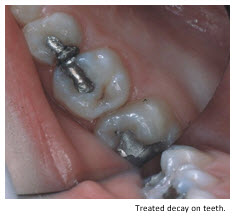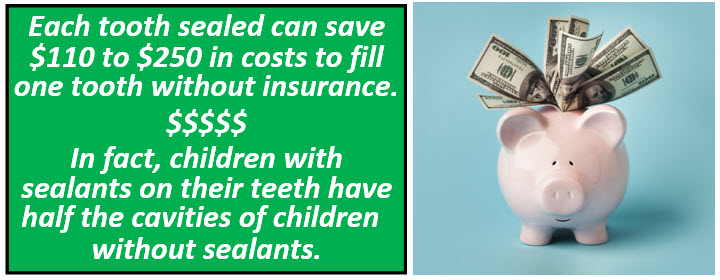Dental Sealants
Dental Sealants - A Cavity Fighting Tool!
What are dental sealants?
Dental sealants are a thin coating painted on the chewing surfaces of the back teeth (molars) to help prevent cavities (tooth decay) for many years. A cavity is a permanent hole in a tooth. If a cavity is not treated, it will get bigger; it can hurt and become infected.
Sealants are placed on teeth in dentist’s offices, clinics and sometimes in schools. Having sealants placed on teeth is simple and painless. Sealants are painted on as a liquid and quickly harden to form a protective coating over the tooth. Sealants are also less expensive and easier to apply than fillings.
How are sealants put on?

Why get sealants?

The most important reason for getting sealants is to avoid tooth decay. Tooth decay is one of the most common childhood diseases. Sealants can reduce decay by 80% for two years and continue to protect against 50% of cavities for up to four years.
Fluoride in toothpaste and in drinking water protects the smooth surfaces of teeth but back teeth need extra protection. Sealants cover the chewing surfaces of the back teeth and help keep out germs and food.
Sealants must be placed on teeth before they decay. Sealants save time and money by avoiding fillings and crowns, which are used to fix decayed teeth.
What causes tooth decay?

The sugar in drinks and food in the mouth is used by germs to make acids. The acids can make a cavity (a hole) in the tooth.
A healthy tooth is the best tooth. It is important to stop decay. That is why sealants are so important.
Why do back teeth decay so easily?
The chewing surfaces of molars are rough and uneven because they have small pits and grooves. Food and germs can get stuck in the pits and grooves and stay there a long time because toothbrush bristles cannot brush them away.
Who should get sealants?
Children should get sealants on their permanent molars as soon as the teeth come in and before decay attacks the teeth. Prevention is always better than the treatment of decay.
The first permanent molars come in when a child is 5 to 7 years old. The second permanent molars come in when a child is 11 to 14 years old. Other teeth with pits and grooves may also need to be sealed. Teenagers and young adults who are prone to decay may also need sealants.
Once applied, sealants protect against 80% of cavities for two years and continue to protect against 50% of cavities for up to four years. Children ages 6 to 11 years without sealants have almost three times more first molar cavities than children with sealants.
Should sealants be put on baby teeth?
Your dentist might think it is a good idea, especially if your child’s baby teeth have deep pits and groves. Baby teeth are important. Baby teeth help a child chew food, speak normally and save space for permanent teeth.
Does insurance pay for sealants?
Missouri Medicaid pays for sealants. Most dental insurance programs will pay for sealants. Check with MO HealthNet or your dental insurance company for details.
How long do sealants last?
Sealants can last up to 10 years. But they need to be checked at regular dental check-up appointments to make sure they are not chipped or worn away. More sealant material can be added to repair sealants.
What if a small cavity is accidentally covered by a sealant?
The decay will not spread because it is sealed off from its food and germ supply.
Are sealants new?
No, sealants have been around since the 1960s. Studies show that sealants are safe and effective. But many people still do not know about sealants.
Other ways to prevent tooth decay

- Brush teeth twice a day using fluoride toothpaste.
- Floss at least once a day.
- Drinking fluoridated water.
- Chew sugar free gum.
- Have a dental check-up every six months.
- Limit snacks between meals, choose foods like plain yogurt or nuts and drink water after snacking.
- Avoid high sugar foods and candy. Avoid foods that will stick to teeth. Avoid chewing ice.
Avoid high sugar and acid found in sodas/pop, sweetened coffees and teas, sports and energy drinks, and fruit juices.
Fluoride…

- Makes teeth more resistant to decay
- Repairs tiny areas of decay before they become big cavities
- Makes germs in the mouth less able to cause decay
Sealants and fluoride both prevent tooth decay but in different ways. Sealants keep germs and food out of the grooves on the chewing surfaces of the back teeth by covering them with a safe protective shield. Fluoride in drinking water and dental products, like toothpaste, protects against cavities by making teeth stronger.
Fluoride most helps the smooth surfaces of the teeth. It is less effective on chewing surfaces of the back teeth, which is why sealants are so important. Regular brushing, with fluoride toothpaste, also helps prevent tooth decay.
Together: sealants, fluoridated water, brushing teeth twice a day with fluoride toothpaste and flossing can help prevent tooth decay.
Where and how to get dental sealants for children
- Ask your child’s dentist to apply sealants when permanent teeth have come in completely.
- Some schools offer sealants as part of a community health program. Ask your school if it has a sealant program. If they do, sign your child up to participate. If they don’t, ask them to start one.
- Some local health departments have sealant programs. Ask your local health department if it has a sealant program.
If you need to find a dentist, use the search option at MO HealthNet, ADA Find a Dentist or Insure Kids Now Dentist Locator.

